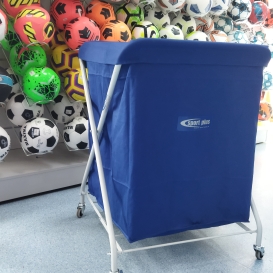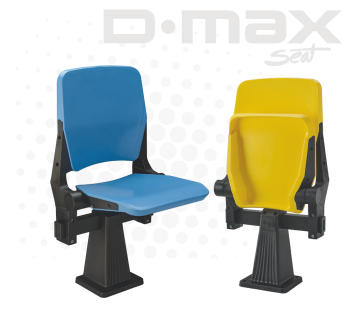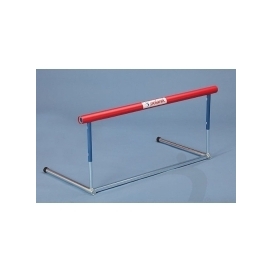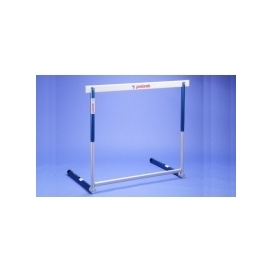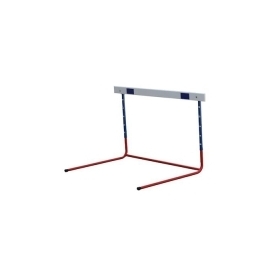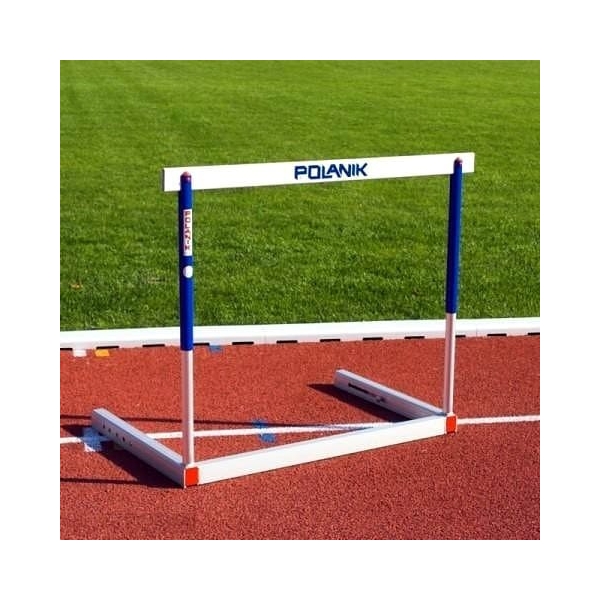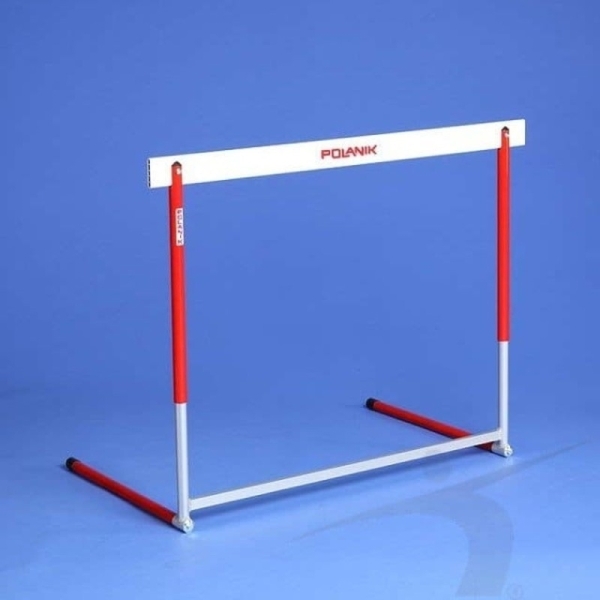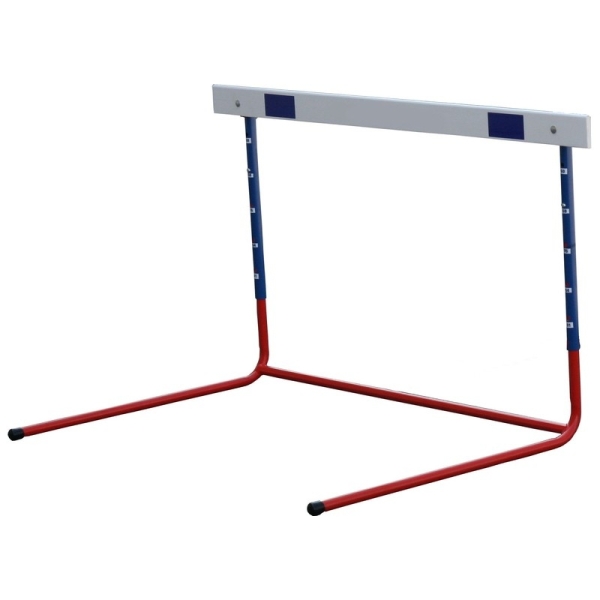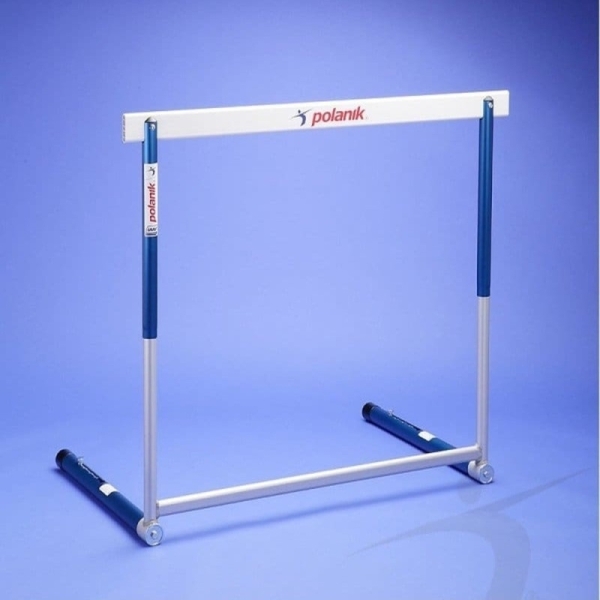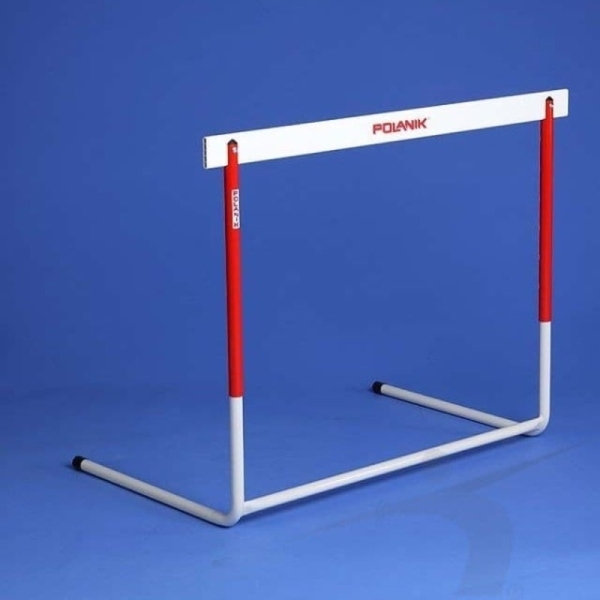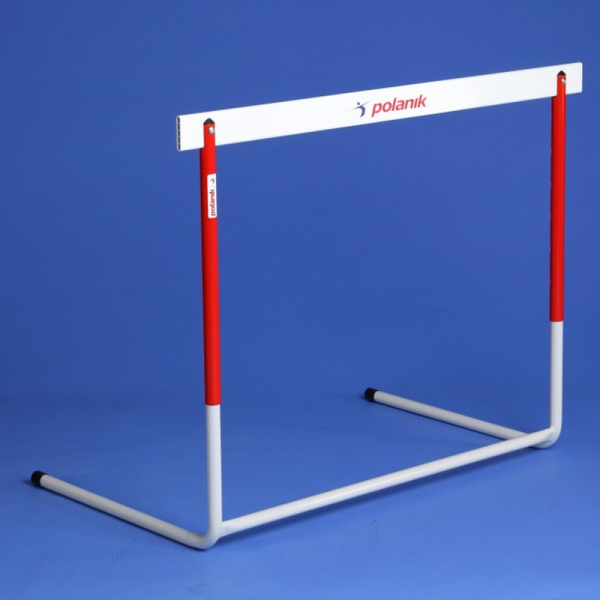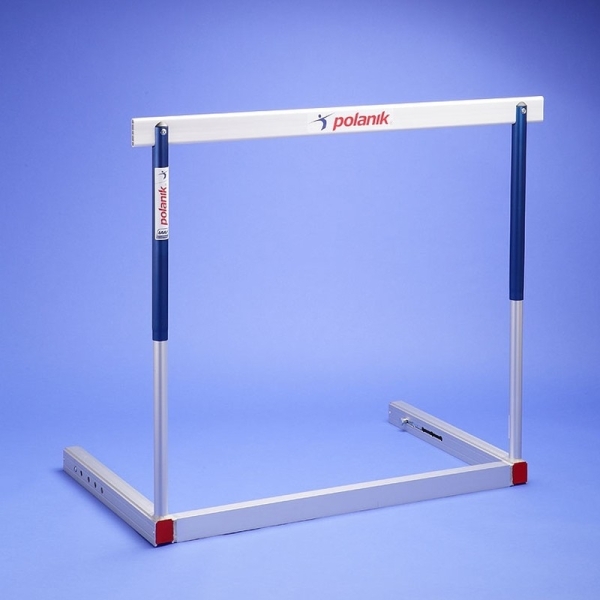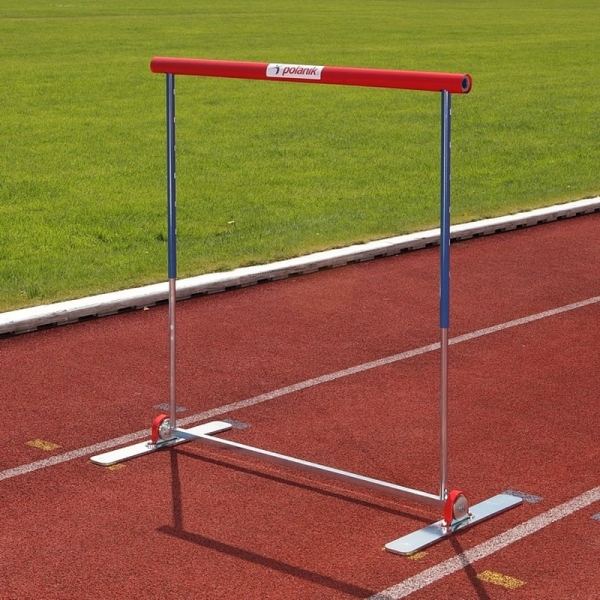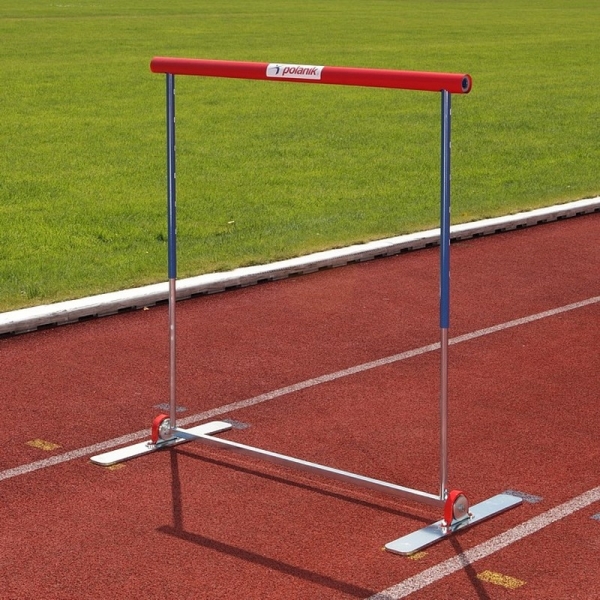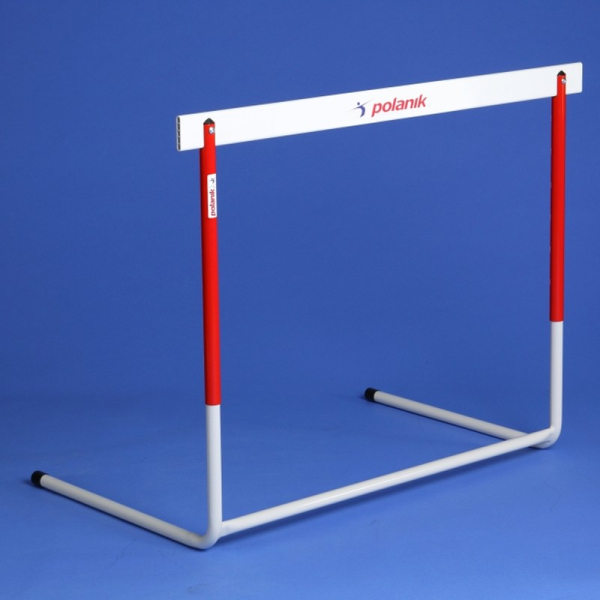Athletic hurdles
Athletic hurdles are an indispensable part of training for every sprinter and hurdler. They facilitate the training of speed, endurance and jumping technique, finding application both during school classes and athletic competitions. The hurdles are characterized by a solid construction made of durable materials, which guarantees their durability and stability. In addition, they are equipped with height adjustment systems, allowing precise adjustment to training requirements. All offered hurdles are certified in accordance with international standards, giving a guarantee of their high quality.Equipment that surpasses expectations - get acquainted with hurdles!
More useful information can be found at the bottom of the page.Subcategories
-
Aluminum-steel school hurdle, bent (height 600-914 mm)
344.40 PLN Tax inc.280.00 PLN NetCatalog no: 12-100
Availability: Made to order -
Performance hurdle, aluminum, 5 positions (height 762-1067 mm)
1,366.54 PLN Tax inc.1,111.01 PLN NetCatalog no: PP-170
Availability: Made to order -
Aluminum hurdle, foldable, 6 positions (height 686-1067 mm)
600.24 PLN Tax inc.488.00 PLN NetCatalog no: 12-40014
Availability: Made to order -
Aluminum-steel school hurdle, bent (height 686-1067 mm)
356.70 PLN Tax inc.290.00 PLN NetCatalog no: 12-101
Availability: Delivery within 24-48 hours -
Stunt hurdle, aluminum, foldable (height 762-1067 mm)
1,248.14 PLN Tax inc.1,014.75 PLN NetCatalog no: 12-40026
Availability: Made to order -
Steel hurdle, bent, 6 positions (height 686-1067 mm)
416.49 PLN Tax inc.338.61 PLN NetCatalog no: 12-40019
Availability: Made to order -
Stunt hurdle, aluminum-steel, foldable, 5 positions (height 762-1067 mm)
901.43 PLN Tax inc.732.87 PLN NetCatalog no: 12-40027
Availability: Made to order -
Tilt fence, 6 positions (height 686-1067 mm)
573.33 PLN Tax inc.466.12 PLN NetCatalog no: 12-40022
Availability: Delivery within 24-48 hours -
Performance hurdle, aluminum, 6 positions (height 686-1067 mm)
1,483.23 PLN Tax inc.1,205.88 PLN NetCatalog no: S-018
Availability: Made to order -
Tilt fence, 5 positions (height 600-914 mm)
573.59 PLN Tax inc.466.33 PLN NetCatalog no: 12-40021
Availability: Made to order -
Tilt fence, 3 positions (height 500-762 mm)
573.59 PLN Tax inc.466.33 PLN NetCatalog no: 12-40020
Availability: Made to order -
Steel fence, bent, 5 positions (height 600-914 mm)
390.68 PLN Tax inc.317.63 PLN NetCatalog no: 12-40018
Availability: Made to order
Helpful information about athletic hurdles in a nutshell
In our assortment you will find athletic hurdles for amateurs and professionals. We offer school variants, training variants, as well as variants for use at sporting events. Athletics hurdles are one of the types of equipment used during multi-competitions. Such competitions include running, jumping or throwing competitions.1 Type and use
Three categories of athletics hurdles allow the equipment to be used in a versatile way, adapting to the needs of different users, from schoolchildren to aspiring amateurs to professional athletes participating in international competitions.- Training hurdles: designed for daily use by athletes at different levels. Their domain is universalism-they are used among all groups of athletes regardless of their level. They feature a durable but lightweight design, allowing easy handling and positioning on a treadmill or in a sports hall. Materials such as aluminum and steel, often used in training hurdles, provide them with adequate strength with minimal weight. click the link
- School hurdles: are designed for youth and novice athletes who are just starting out in athletics. These are usually lighter and more economical versions of hurdles, made of materials that ensure safety and durability for daily use. The design often includes additional safety features to minimize the risk of injury. School hurdles are ideal for use during physical education lessons, school sports competitions and initial athletic training, allowing young athletes to safely develop their skills. click the link
- Moreover, hurdles in these categories are divided into three types, which have their own unique characteristics and specialize the equipment in separate aspects. Flexible hur dles are characterized by a permanent, high-strength construction, making them extremely durable and resistant to heavy use. They are ideal for applications where structural stability is a priority. Folding hurdles are easy to store and transport thanks to their ability to fold down to a compact size. They are an ideal choice for schools and sports clubs, where there is often a need to move and store equipment in limited spaces. Tilt hurdles provide additional safety as they tilt up in the event of contact with an athlete, minimizing the risk of injury. This makes them ideal for younger people and beginners, providing a safe environment for them to learn and improve their technique.
- High-performance hurdles: this equipment is designed for professional athletes who participate in top-level competitions. The construction of these hurdles meets all international standards and is certified by WA (World Athletics), which is necessary for their use in official competitions. Made of the highest quality materials, these hurdles are extremely durable and stable, making them reliable during competitions. click the link
- All models are made of materials that provide excellent strength and durability. This makes our products an ideal choice for anyone who wants to develop their athletic skills. In addition to high-quality materials, our athletics hurdles feature innovative technical solutions that allow them to be easily and quickly set up on the track. They are also fully adjustable, making it easy to adjust their height to suit the needs of athletes.
2 Adjustment and technical solutions
Height adjustment:- Athletic hurdles offer precise height adjustment mechanisms, which is key to adapting the equipment to different training levels and age groups. Training, performance and school hurdles are equipped with telescopic tubes with snap-in mechanisms that make it easy and quick to set the desired height. Standard adjustment ranges range from 500 mm to 1,067 mm, with precise levels tailored to training and regulatory requirements. The mechanisms are often made of aluminum or stainless steel, ensuring durability and resistance to heavy use. High-performance hurdles use additional systems for precise height adjustment, allowing hurdles to be quickly adjusted during competition, without the need for tools.
Key technical solutions:
- The athletic hurdles use a number of advanced technical solutions that enhance their functionality, safety and convenience. The use of steel weights in the bases of the hurdles guarantees their stability even during intensive training and competitions. Competitive hurdles often use counterweight systems, which further increase stability and allow the hurdles to move smoothly on the treadmill. In addition, mobility and ease of storage are key aspects in the design of athletic hurdles.
- Many models, especially training and school hurdles, are equipped with folding mechanisms that allow the hurdles to be quickly and conveniently folded into a compact size. This allows them to be easily stored and transported. High-performance hurdles often have special foot profiles, allowing one hurdle to be folded on top of another, which saves space and makes them easier to organize in the stadium or in storage. High-performance hurdles and some training models are equipped with casters, which make them much easier to move around the treadmill. These wheels are often made of durable plastic, which is resistant to wear and tear and ensures that the hurdles move smoothly without damaging the treadmill surface. In addition, special handles and ergonomic design features allow the hurdles to be easily lifted and placed in position.
- The school and training hurdles use solutions that minimize the risk of injury, such as rounded edges, soft covers for the crossbars and shock-absorbing design elements. These features ensure that young athletes and novice athletes can train without fear of injury. In high-performance hurdles, safety is also a priority, hence the use of precise adjustment mechanisms. Thanks to these advanced technical solutions, athletic hurdles offer versatility, durability and safety, meeting the highest requirements of both amateurs and professionals.
3. materials and construction
Construction:- The basic part of the hurdles is a metal frame, which is both lightweight and strong. The frames of hurdles are most often made of aluminum, which has an excellent strength-to-weight ratio and corrosion resistance. Some hurdles, especially those designed for school use, can be made of galvanized steel, which provides additional protection against corrosion. The crossbar of hurdles, over which athletes jump, is flexible and covered with a soft cover to minimize the risk of injury.
- Height adjustment mechanisms typically rely on telescopic tubes that can be moved smoothly and locked at the desired height. Telescopic tubes are made of aluminum or stainless steel for strength and wear resistance. Latching height-locking mechanisms are often made of durable plastics or metals, which ensure that the crossbar is securely and safely held at the desired height. The stability of athletic hurdles is ensured by solid bases, which often include weights. The bases are made of high-strength steel and can be equipped with rubber pads that increase adhesion to the ground and prevent the hurdles from moving during use. The weights, located in the bases, can be made of steel or cast iron and are designed to lower the hurdle's center of gravity, which increases its stability. Some models of performance hurdles use counterweights with adjustable weight distribution to further stabilize the hurdle during running.
Materials:
- Aluminum is one of the most commonly used materials in the production of athletic hurdles due to its lightness, strength and corrosion resistance. It is used for both the construction of the frames and the telescopic height adjustment tubes. The electrochemical process of anodizing, which involves the formation of a hard layer of aluminum oxide on the surface of aluminum after an electrolytic bath in sulfuric acid, further increases the material's durability and resistance to weathering.
- Steel, especially galvanized or stainless steel, is used in fence structures that require exceptional strength. Steel elements are more resistant to mechanical damage and can withstand intensive use for a long time. Galvanized steel, thanks to the galvanization process, which involves immersing steel elements in an electrolytic bath containing zinc compounds - under the influence of an electric current, zinc ions from the solution are deposited on the surface of the steel, which forms a thin protective coating that is particularly resistant to corrosion and mechanical damage. Therefore, such steel is ideal for outdoor applications.
- High-strength plastics, such as polypropylene or polycarbonate, are used for crossbars and control elements. These materials have excellent impact resistance and flexibility, minimizing the risk of damage upon contact with the player.
- Rubber overlays or composites are often used in the bases of hurdles to increase adhesion to the ground and prevent hurdles from sliding. These materials are also resistant to wear and weather conditions, making the hurdles suitable for use in a variety of environments without losing their functionality.
We encourage you to browse our range of athletic hurdles or contact us so that we can select the most suitable and adequate model to suit your needs.



